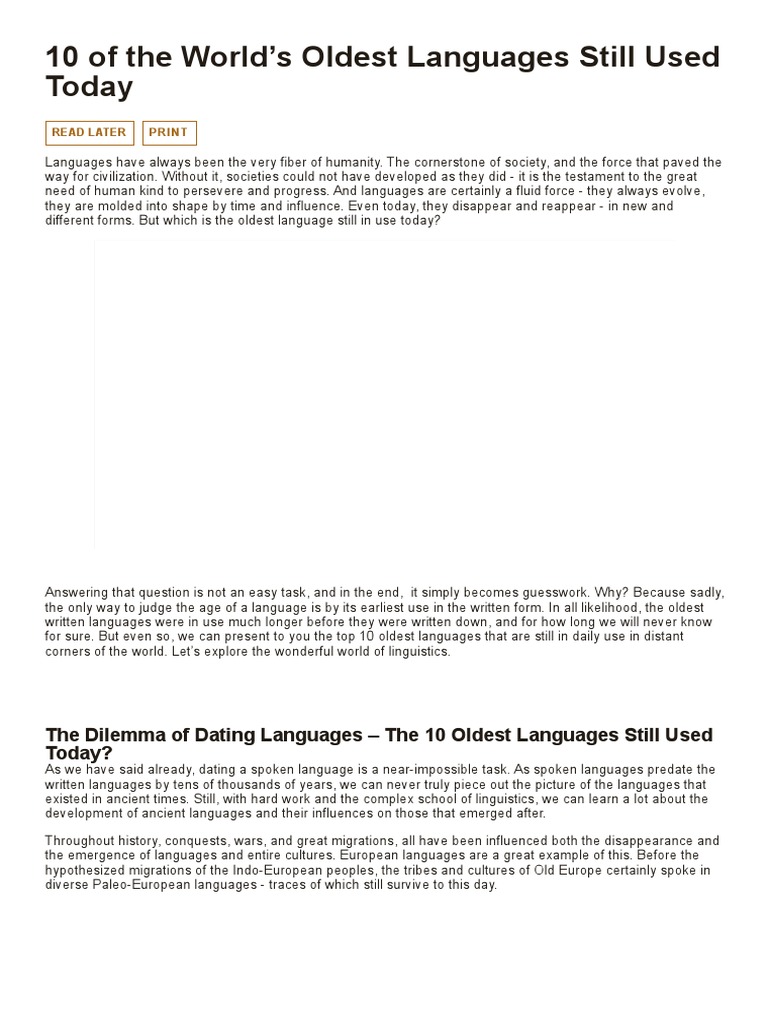Language serves as a window into the past, illuminating our understanding of human civilization and cultural evolution. Among the myriad languages spoken across the globe, some stand out not only for their unique characteristics but also for their profound histories. Language isolates, in particular, intrigue linguists and anthropologists alike. These are languages that cannot be conclusively linked to any existing language family. They remain enigmatic remnants of a bygone era. This discussion will encapsulate the essence of the oldest language isolates that are still in use today, revealing their fascinating attributes and underlying reasons behind their enduring survival.
The allure of language isolates is undeniable. They embody a sense of mystery and uniqueness, prompting questions about how their speakers have maintained these languages over centuries, often in the face of overwhelming external influences and sociopolitical changes. The languages in question are often spoken by small populations, isolated by geography or culture, which has led to a preservation of linguistic features thought to be long extinct in more widely spoken languages. A closer examination of these isolates highlights the complex interplay between culture, identity, and communication.
One prominent example is Euskara, also known as Basque, spoken in the Basque Country that straddles the border between Spain and France. Euskara’s origins are debated, with some theories positing links to prehistoric languages spoken in Europe, while others concede its status as a true isolate. What makes Euskara particularly fascinating is its resilience. Despite the pressures of both Spanish and French language dominance, the Basque community has fiercely preserved and revitalized its native tongue through educational programs and cultural initiatives. Euskara’s survival not only symbolizes regional pride but also serves as a pedagogical tool for examining historical identity and the influences of migration and conquest in shaping linguistic landscapes.
Another critical example is the Ainu language, spoken by the indigenous Ainu people in Japan. Ainu has experienced considerable decline, with only a few fluent speakers remaining. Nevertheless, cultural revitalization efforts have sparked a renewed interest in teaching and preserving this ancient tongue. Ainu is distinguished by its rich oral traditions, which convey historical narratives and ecological knowledge unique to the Ainu worldview. The relatively small number of speakers has not precluded the language from being recognized as culturally significant, shedding light on the intricate relationship between language, identity, and the preservation of indigenous heritage.
Moving further afield, we encounter the indigenous languages of Papua New Guinea, a veritable treasure trove of isolates. With over 800 distinct languages, including several isolates, this region offers a vibrant tapestry of linguistic diversity. One notable isolate is the language of the Tuwali people, located in a remote area of the Highlands. The Tuwali language illustrates the profound connection between culture and landscape. The intricate vocabulary related to flora, fauna, and geography demonstrates the community’s deep-rooted engagement with their surroundings, showcasing how language serves as a vital cultural repository.
Language isolates, by their very nature, challenge conventional linguistic theories. They compel us to reconsider notions of language evolution and the interconnectedness of human communication. Typically, languages evolve and borrow elements from neighboring tongues, creating a web of relationships within linguistic families. In contrast, isolates tend to retain archaic features, presenting a linguistic snapshot of earlier stages of human expression. This phenomenon offers remarkable insights into human cognition, social structures, and the various ways communities navigate their realities.
The survival of these languages often reflects broader sociopolitical contexts. Indigenous communities, for instance, have faced existential threats from colonization, globalization, and modernization. Their languages, seen merely as tools of communication by outsiders, hold far richer meanings tied to identity, spirituality, and tradition for the speakers. This intrinsic value fosters a sense of urgency among community members to preserve and revitalize their native tongues. Advocacy efforts, such as cultural festivals, language workshops, and official recognition, have proved pivotal in ensuring the relevance and vitality of these ancient tongues. The Basque and Ainu communities exemplify how cultural pride and sociopolitical endeavors intersect in the quest to sustain linguistic heritage.
In addition to the cultural implications, studying language isolates also contributes to the field of linguistics by highlighting the cognitive aspects of language acquisition and maintenance. The mechanics of how these languages function can often be distinct from those in more broadly spoken languages, providing invaluable data for researchers. Investigating the phonetics, syntax, and morphology of isolates fosters a deeper understanding of how human language operates at a fundamental level. These linguistic peculiarities not only enrich our comprehension of human communication but also reveal the cognitive challenges and adaptations faced by speakers of these languages in a rapidly changing world.
Conclusively, the world’s oldest language isolates are not merely curiosities of linguistic anthropology; they represent a profound legacy of human creativity and resilience. Their continued existence in the face of adversity speaks volumes about the human spirit’s determination to preserve identity and culture. These languages serve as conduits for memory, history, and cultural continuity, reminding us of the intricate tapestry of human expression that transcends time and geography. As we delve deeper into understanding these languages, we unlock not only the keys to linguistic heritage but also the collective narratives that define humanity’s journey through time.
